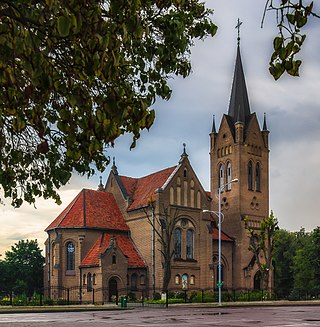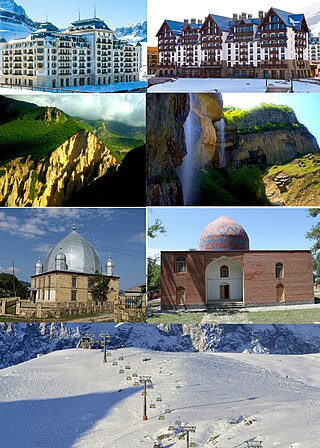
Asipovichy is a town in Mogilev Region, Belarus. It serves as the administrative center of Asipovichy District. It is located 136 kilometres (85 mi) southwest of Mogilev, 3 kilometres (1.9 mi) south of the Minsk-Gomel expressway. It is located at the junction of railway lines between Minsk, Gomel, Mogilev, and Baranavichy. In 2020, its population was 29,900. As of 2024, it has a population of 29,103.

Salihorsk or Soligorsk is a city in Minsk Region, Belarus. It serves as the administrative center of Salihorsk District. As of 2024, it has a population of 97,818.

Nyasvizh or Nesvizh is a town in Minsk Region, Belarus. It serves as the administrative centre of Nyasvizh District. Nyasvizh is the site of Nesvizh Castle, a World Heritage Site. In 2009, its population was 14,300. As of 2024, it has a population of 15,968.
Yardimli is a city in and the capital of the Yardimli District of Azerbaijan. It is in the Talysh Mountains, a northwestern subrange of the Alborz (Elburz) mountain range, about 286 km to the south from Baku and 76 km to the south-west from Masallı.

Vileyka or Vilyeyka is a town in Minsk Region, Belarus. It serves as the administrative center of Vileyka District. It is located on the Viliya River, 100 kilometres (62 mi) northwest of Minsk. The first historical record dates from 16 November 1460. As of 2024, the town has a population of 26,625.

Pochaiv is a city in Kremenets Raion, Ternopil Oblast, western Ukraine. It is located 18 kilometres (11 mi) south-west of Kremenets and 70 kilometres (43 mi) north of the administrative center of the oblast, Ternopil. It hosts the administration of Pochaiv urban hromada, one of the hromadas of Ukraine. Population: 7,633.

Rozhyshche is a city in Volyn Oblast, Ukraine. It serves as an administrative center of Rozhyshche urban hromada. Population: 12,483.

Kamianka-Dniprovska is a city in Zaporizhzhia Oblast, Ukraine. It served as the administrative center of the former Kamianka-Dniprovska Raion until that raion was merged into Vasylivka Raion in 2020. Population: 12,117.
Hlobyne is a city in Kremenchuk Raion, Poltava Oblast, Ukraine. It hosts the administration of Hlobyne urban hromada, one of the hromadas of Ukraine. Population: 8,955.

Dobropillia is a city in Pokrovsk Raion, Donetsk Oblast, Ukraine. Prior to 2020, it was a city of oblast significance and served as the administrative center of the former Dobropillia Raion, though it did not belong to the raion. It is located 94 kilometres (58 mi) from Donetsk, the administrative center of the oblast. Population: 28,170 ; 40,064 (1989);

Vashkivtsi is a city in Vyzhnytsia Raion of Chernivtsi Oblast (province) of Ukraine. It is located in the historical region of Bukovina. It hosts the administration of Vashkivtsi urban hromada, one of the hromadas of Ukraine. Population: 5,215.

Talne is a city in Zvenyhorodka Raion, Cherkasy Oblast (province) of Ukraine. It hosts the administration of Talne urban hromada, one of the hromadas of Ukraine. It had a population of 12,839.

Qusar is the capital of Qusar District, Azerbaijan. Qusar is located in the foothills of the Greater Caucasus, over the Qusarchay River, 35 kilometers southwest from Khudat railway station and about 180 km from Baku.
Binəqədi is an urban-type settlement and municipality in the eponymous Binəqədi raion of Baku, Azerbaijan. It is located 7 km (4.3 mi) from the Biləcəri railway station.

Krupki is a town in Minsk Region, Belarus. It serves as the administrative center of Krupki District.
Yablunets is an urban-type settlement in Zviahel Raion, Zhytomyr Oblast, Ukraine. Population: 1,078

Lokachi is a rural settlement in Volyn Oblast (province), located in the historic region of the Volhynia. It is an administrative seat of the Lokachi settlement hromada. Population: 3,698

Oleksandrivka is a rural settlement in Donetsk Oblast, eastern Ukraine. It is located in the industrial region of the Donets basin. It is currently located in Kramatorsk Raion, but was formerly the administrative seat of Oleksandrivka Raion before the raion's abolition in 2020. Population: 3,338.
Yangiqoʻrgʻon is an urban-type settlement and the administrative center of Yangiqoʻrgʻon District, Namangan Region, Uzbekistan. Population: 11,561.

Ros is an urban-type settlement in Vawkavysk District, Grodno Region, in western Belarus. It is situated on the Ros River, a left tributary of the Neman. As of 2024, it has a population of 4,407.


















